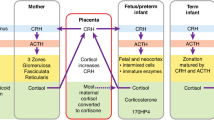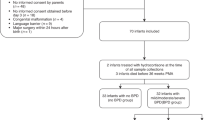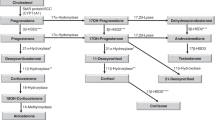Abstract
Summary: Plasma aldosterone (A), corticosterone (B), deoxycorticosterone (DOC), progesterone (P), 17-hydroxyprogesterone (17-OHP), cortisol (F), and cortisone (E) were measured simultaneously by specific radioimmunoassays in small plasma samples obtained from 174 normal infants and children between 2 hr and 15 yr of age. The significantly elevated neonatal mean levels (ng/ml) of 2.5 (A), 4.1 (DOC), 53.0 (P), and 6.6 (17-OHP) dropped significantly during infancy reaching prepubertal levels between 3 months and 3 yr of age, with a transient, significant DOC increase between 1-7 yr. The glucocorticoids F and B declined significantly from means of 68 and 4.4 to 11.4 and 0.28 ng/ml, respectively, during the first weeks of life, then increased significantly reaching adult levels between 1-3 yr of age. Mean E fell progressively from 74 ng/ml after birth to 10 ng/ml during 1-5 yr (P << 0.0001), then slightly increased to adult levels. After age 7 yr, P and 17-OHP, in contrast to the other steroids, rose significantly in both boys and girls relative to pubertal development.
The observed changes are thought to be due to (1) adaptation of the adrenal neocortex to extrauterine life after disruption of the fetoplacental unit, (2) a physiologic lack of corticosteroid binding globulin (CBG) during infancy due to maturation of hepatic CBG biosynthesis, (3) the functional immaturity of the infant kidney compensated by an increased activity of the renin-angiotensin-aldosterone system, and (4) gradually increasing gonadal secretion of progestins during puberty.
Speculation: From birth to adulthood, marked evolutional changes were observed in the basal plasma concentrations of all physiologically important unconjugated corticosteroids and progestins in normal children. Detailed knowledge of the age-dependent normal plasma steroid pattern reflecting maturational processes of both the hypothalamo-adrenocortical and the hypothalamo-gonadal axis, of the renin-angiotensin-aldosterone system, and of hepatic and renal function, therefore, is a prerequisite for understanding pathologic conditions in pediatric endocrinology.
Similar content being viewed by others
Log in or create a free account to read this content
Gain free access to this article, as well as selected content from this journal and more on nature.com
or
Author information
Authors and Affiliations
Rights and permissions
About this article
Cite this article
Sippell, W., Dörr, H., Bidlingmaier, F. et al. Plasma Levels of Aldosterone, Corticosterone, 11-Deoxycorticosterone, Progesterone, 17-Hydroxyprogesterone, Cortisol, and Cortisone During Infancy and Childhood. Pediatr Res 14, 39–46 (1980). https://doi.org/10.1203/00006450-198001000-00010
Issue date:
DOI: https://doi.org/10.1203/00006450-198001000-00010
Keywords
This article is cited by
-
Treatment and health outcomes in adults with congenital adrenal hyperplasia
Nature Reviews Endocrinology (2014)
-
Impacts of stress and sex hormones on dopamine neurotransmission in the adolescent brain
Psychopharmacology (2014)
-
Dynamic molecular and anatomical changes in the glucocorticoid receptor in human cortical development
Molecular Psychiatry (2011)



